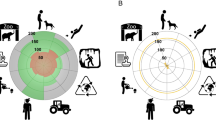Abstract
Where vegetation is managed for nature conservation, results should be assessed against criteria linked to the objectives of management. An assessment method is presented in which the goal vegetation was defined as a specific biotope limited by a set of biophysical conditions. Vegetation was sampled from field boundary strips intended for the conservation of arable plant communities. Species suited to the specified conditions (suited species) were defined by applying rule sets to a matrix of species with their traits and habitat preferences, compiled from a range of data sources. The proportional contribution of suited species to the total vegetation was calculated for each set of conditions. Scores for each condition (suited species scores) were combined to provide overall comparative site values representing the extent to which the goal vegetation was established. There was close correlation with results of a previous assessment by expert opinion poll. Variation between sites in soil type and cultivation frequency was reflected by differences in individual suited species scores. Ideally, suited species selection would be by traits alone but currently there are insufficient data available. The method is readily applicable to other vegetation types.
Similar content being viewed by others
References
Anselin A, Meire PM and Anselin L (1989) Multicriteria techniques in ecological evaluation: an example using the analytical hierarchy process. Biological Conservation 49: 215–229
Burrows CJ (1990) Processes of Vegetation Change. Unwin Hyman, London
Clapham AR, Tutin TG and Moore DM (1987) Flora of the British Isles. Cambridge University Press, Cambridge
Critchley CNR (1996a) Monitoring as a feedback mechanism for the conservation management of arable plant communities. Aspects of Applied Biology 44: 239–244
Critchley CNR (1996b) Vegetation of arable field margins in Breckland. PhD thesis. University of East Anglia, Norwich
Critchley CNR, Smart SM, Poulton SMC and Myers GM (1996) Monitoring the consequences of vegetation management in Environmentally Sensitive Areas. Aspects of Applied Biology 44: 193–201
Díaz S and Cabido M (1997) Plant functional types and ecosystem function in relation to global change. Journal of Vegetation Science 8: 463–474
Dony JG and Denholm I (1985) Some quantitative methods of assessing the conservation value of ecologically similar sites. Journal of Applied Ecology 22: 229–238
Ellenberg H (1974) Indicator values of vascular plants in Central Europe. Scripta Geobotanica 9: 5–97
Ellenberg H (1988) Vegetation Ecology of Central Europe. Cambridge University Press, Cambridge
Etherington JR (1982) Environment and Plant Ecology (2nd edn). John Wiley and Sons, Chichester
Firbank LG, Lintell-Smith G, McCloskey M, Smith JM and Webb DJ (1993) Scale, experimental design and the detection of interspecific competition within plant communities. Plant Species Biology 8: 159–166
Fitter AH and Peat HJ (1994) The Ecological Flora Database. Journal of Ecology 82: 415–425
Goldsmith FB (1975) The evaluation of ecological resources in the countryside for conservation purposes. Biological Conservation 8: 89–96
Goss MJ, Williams BL and Howse KR (1991) Organic matter turnover and nitrate leaching. In: Wilson WS (ed) Cambridge, Advances in Soil Organic Matter Research: The Impact on Agriculture and the Environment, pp 107–114. Royal Society of Chemistry
Götmark F, Ahlund M and Eriksson M (1986) Are indices reliable for assessing conservation value of natural areas-an avian case study. Biological Conservation 38: 55–73
Gough MW and Marrs RH (1990a) A comparison of soil fertility between semi-natural and agricultural plant communities: implications for the creation of floristically rich grassland on abandoned agricultural land. Biological Conservation 51: 83–96
Gough MW and Marrs RH (1990b) Trends in soil chemistry and floristics associated with the establishment of a low-input meadow system on an arable clay soil in Essex, England. Biological Conservation 52: 135–146
Grime JP (1974) Vegetation classification by reference to strategies. Nature 250: 26–31
Grime JP (1979) Plant Strategies and Vegetation Processes. Wiley, Chichester
Grime JP, Hodgson JG and Hunt R (1988) Comparative Plant Ecology. Unwin Hyman, London
Grime JP, Thompson K, Hunt R, Hodgson JG, Cornelissen JHC, Rorison IH, Hendry GAF, Ashenden TW, Askew AP, Band SR, Booth RE, Bossard CC, Campbell BD, Cooper JEL, Davison AW, Gupta PL, Hall W, Hand DW, Hannah MA, Hillier SH, Hodkinson DJ, Jalili A, Liu Z, Mackey JML, Matthews N, Mowforth MA, Neal AM, Reader RJ, Reiling K, Ross-Fraser W, Spencer RE, Sutton F, Tasker DE, Thorpe PC and Whitehouse J (1997) Integrated screening validates primary axes of specialisation in plants. Oikos 79: 259–281
Hill MO and Carey PD (1997) Prediction of yield in the Rothamstead Park Grass Experiment by Ellenberg indicator values. Journal of Vegetation Science 8: 579–586
Hodgson JG, Grime JP, Hunt R and Thompson K (1995) The Electronic Comparative Plant Ecology. Chapman & Hall, London
Hodkinson DJ, Critchley CNR and Sherwood AJ (1997) A botanical survey of conservation headlands in Breckland. In: Brighton Crop Protection Conference-Weeds-1997, pp 979–984. BCPC, Farnham
Holzner W (1978) Weed species and weed communities. Vegetatio 38: 13–20
Keddy PA (1992) A pragmatic approach to functional ecology. Functional Ecology 6: 621–626
Lavorel S, McIntyre S, Landsberg J and Forbes TDA (1997) Plant functional classifications: from general groups to specific groups based on response to disturbance. Trends in Ecology and Evolution 12: 474–478
Marrs RH, Gough MW and Griffiths M (1991) Soil chemistry and leaching loss of nutrients from seminatural grassland and arable soils on three contrasting parent materials. Biological Conservation 57: 257–271
NCC (1984) SSSI Notification for Cherry Hill and the Gallops, Barton Mills, Suffolk. English Nature, Bury St. Edmunds
Odum EP, Pinder JE and Christiansen TA (1984) Nutrient losses from sandy soils during old field succession. American Midland Naturalist 111: 148–154
Paul EA (1976) Nitrogen cycling in terrestrial ecosystems. In: Nriagu JO (ed) Environmental Biogeochemistry. Vol. 1. Carbon, Nitrogen, Phosphorous, Sulfur and Selenium Cycles, pp 225–243. Ann Arbor Science, Ann Arbor, Michigan
Peat JR (1984) A partially objective method for the ecological evaluation of biological communities. PhD Thesis. University of Southampton, Southampton
Ratcliffe DA (ed) (1977) A Nature Conservation Review, Volume 1. Cambridge University Press, Cambridge
Rodwell JS (ed) (1991 et seq.) British Plant Communities. Cambridge University Press, Cambridge
Rushton SP and Sanderson RA (1996) The effects of grazing management on moorland vegetation: a comparison of farm unit, grazing paddock and plot experiments using a community modelling approach. Aspects of Applied Biology 44: 211–219
Smith PGR and Theberge JB (1987) Evaluating natural areas using multiple criteria: theory and practice. Environmental Management 11: 447–460
Stace C (1991) New Flora of the British Isles. Cambridge University Press, Cambridge
Thompson K (1994) Predicting the fate of temperate species in response to human disturbance and global change. In: Boyle TJB and Boyle CEB (eds) NATO Advanced Research Workshop on Biodiversity, Temperate Ecosystems and Global Change, pp 61–76. Springer-Verlag, Berlin
Thompson K, Hodgson JG, Grime JP, Rorison IH, Band SR and Spencer RE (1993) Ellenberg numbers revisited. Phytocoenologia 23: 277–289
Trist PJO (ed) (1979) An Ecological Flora of Breckland. EP Publishing Limited, Wakefield
Voogd H (1982) Multicriteria evaluation with mixed qualitative and quantitative data. Environment and Planning B 9: 221–236
Wathern P, Young SN, Brown IW and Roberts DA (1986) Ecological evaluation techniques. Landscape Planning 12: 403–420
Watt AS (1936) Studies on the ecology of Breckland. I. Climate, soil and vegetation. Journal of Ecology 24: 117–138
Zar JH (1984) Biostatistical Analysis (2nd edn). Prentice-Hall, Englewood Cliffs, New Jersey
Author information
Authors and Affiliations
Rights and permissions
About this article
Cite this article
Critchley, C. Ecological assessment of plant communities by reference to species traits and habitat preferences. Biodiversity and Conservation 9, 87–105 (2000). https://doi.org/10.1023/A:1008976014424
Issue Date:
DOI: https://doi.org/10.1023/A:1008976014424




